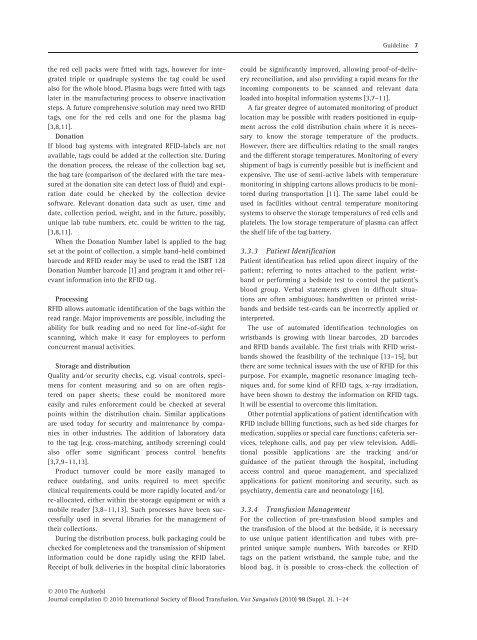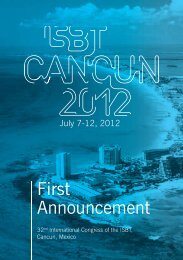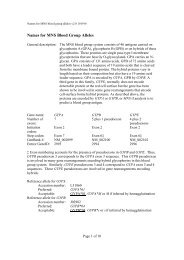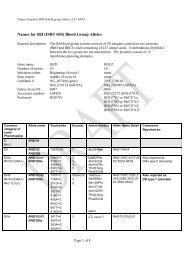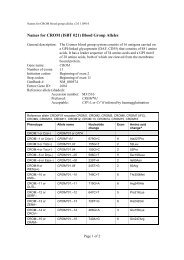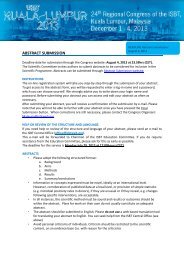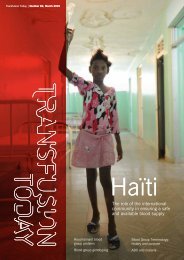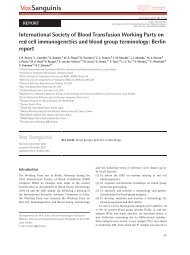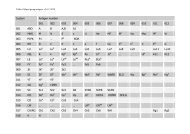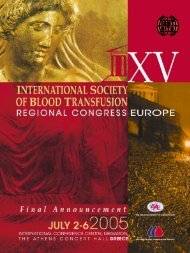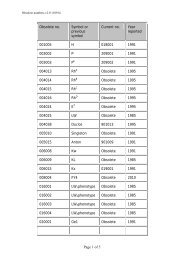Guidelines for the Use of RFID Technology in Transfusion Medicine
Guidelines for the Use of RFID Technology in Transfusion Medicine
Guidelines for the Use of RFID Technology in Transfusion Medicine
You also want an ePaper? Increase the reach of your titles
YUMPU automatically turns print PDFs into web optimized ePapers that Google loves.
Guidel<strong>in</strong>e 7<strong>the</strong> red cell packs were fitted with tags, however <strong>for</strong> <strong>in</strong>tegratedtriple or quadruple systems <strong>the</strong> tag could be usedalso <strong>for</strong> <strong>the</strong> whole blood. Plasma bags were fitted with tagslater <strong>in</strong> <strong>the</strong> manufactur<strong>in</strong>g process to observe <strong>in</strong>activationsteps. A future comprehensive solution may need two <strong>RFID</strong>tags, one <strong>for</strong> <strong>the</strong> red cells and one <strong>for</strong> <strong>the</strong> plasma bag[3,8,11].DonationIf blood bag systems with <strong>in</strong>tegrated <strong>RFID</strong>-labels are notavailable, tags could be added at <strong>the</strong> collection site. Dur<strong>in</strong>g<strong>the</strong> donation process, <strong>the</strong> release <strong>of</strong> <strong>the</strong> collection bag set,<strong>the</strong> bag tare (comparison <strong>of</strong> <strong>the</strong> declared with <strong>the</strong> tare measuredat <strong>the</strong> donation site can detect loss <strong>of</strong> fluid) and expirationdate could be checked by <strong>the</strong> collection devices<strong>of</strong>tware. Relevant donation data such as user, time anddate, collection period, weight, and <strong>in</strong> <strong>the</strong> future, possibly,unique lab tube numbers, etc. could be written to <strong>the</strong> tag.[3,8,11].When <strong>the</strong> Donation Number label is applied to <strong>the</strong> bagset at <strong>the</strong> po<strong>in</strong>t <strong>of</strong> collection, a simple hand-held comb<strong>in</strong>edbarcode and <strong>RFID</strong> reader may be used to read <strong>the</strong> ISBT 128Donation Number barcode [1] and program it and o<strong>the</strong>r relevant<strong>in</strong><strong>for</strong>mation <strong>in</strong>to <strong>the</strong> <strong>RFID</strong> tag.Process<strong>in</strong>g<strong>RFID</strong> allows automatic identification <strong>of</strong> <strong>the</strong> bags with<strong>in</strong> <strong>the</strong>read range. Major improvements are possible, <strong>in</strong>clud<strong>in</strong>g <strong>the</strong>ability <strong>for</strong> bulk read<strong>in</strong>g and no need <strong>for</strong> l<strong>in</strong>e-<strong>of</strong>-sight <strong>for</strong>scann<strong>in</strong>g, which make it easy <strong>for</strong> employees to per<strong>for</strong>mconcurrent manual activities.Storage and distributionQuality and ⁄ or security checks, e.g. visual controls, specimens<strong>for</strong> content measur<strong>in</strong>g and so on are <strong>of</strong>ten registeredon paper sheets; <strong>the</strong>se could be monitored moreeasily and rules en<strong>for</strong>cement could be checked at severalpo<strong>in</strong>ts with<strong>in</strong> <strong>the</strong> distribution cha<strong>in</strong>. Similar applicationsare used today <strong>for</strong> security and ma<strong>in</strong>tenance by companies<strong>in</strong> o<strong>the</strong>r <strong>in</strong>dustries. The addition <strong>of</strong> laboratory datato <strong>the</strong> tag (e.g. cross-match<strong>in</strong>g, antibody screen<strong>in</strong>g) couldalso <strong>of</strong>fer some significant process control benefits[3,7,9–11,13].Product turnover could be more easily managed toreduce outdat<strong>in</strong>g, and units required to meet specificcl<strong>in</strong>ical requirements could be more rapidly located and ⁄ orre-allocated, ei<strong>the</strong>r with<strong>in</strong> <strong>the</strong> storage equipment or with amobile reader [3,8–11,13]. Such processes have been successfullyused <strong>in</strong> several libraries <strong>for</strong> <strong>the</strong> management <strong>of</strong><strong>the</strong>ir collections.Dur<strong>in</strong>g <strong>the</strong> distribution process, bulk packag<strong>in</strong>g could bechecked <strong>for</strong> completeness and <strong>the</strong> transmission <strong>of</strong> shipment<strong>in</strong><strong>for</strong>mation could be done rapidly us<strong>in</strong>g <strong>the</strong> <strong>RFID</strong> label.Receipt <strong>of</strong> bulk deliveries <strong>in</strong> <strong>the</strong> hospital cl<strong>in</strong>ic laboratoriescould be significantly improved, allow<strong>in</strong>g pro<strong>of</strong>-<strong>of</strong>-deliveryreconciliation, and also provid<strong>in</strong>g a rapid means <strong>for</strong> <strong>the</strong><strong>in</strong>com<strong>in</strong>g components to be scanned and relevant dataloaded <strong>in</strong>to hospital <strong>in</strong><strong>for</strong>mation systems [3,7–11].A far greater degree <strong>of</strong> automated monitor<strong>in</strong>g <strong>of</strong> productlocation may be possible with readers positioned <strong>in</strong> equipmentacross <strong>the</strong> cold distribution cha<strong>in</strong> where it is necessaryto know <strong>the</strong> storage temperature <strong>of</strong> <strong>the</strong> products.However, <strong>the</strong>re are difficulties relat<strong>in</strong>g to <strong>the</strong> small rangesand <strong>the</strong> different storage temperatures. Monitor<strong>in</strong>g <strong>of</strong> everyshipment <strong>of</strong> bags is currently possible but is <strong>in</strong>efficient andexpensive. The use <strong>of</strong> semi-active labels with temperaturemonitor<strong>in</strong>g <strong>in</strong> shipp<strong>in</strong>g cartons allows products to be monitoreddur<strong>in</strong>g transportation [11]. The same label could beused <strong>in</strong> facilities without central temperature monitor<strong>in</strong>gsystems to observe <strong>the</strong> storage temperatures <strong>of</strong> red cells andplatelets. The low storage temperature <strong>of</strong> plasma can affect<strong>the</strong> shelf life <strong>of</strong> <strong>the</strong> tag battery.3.3.3 Patient IdentificationPatient identification has relied upon direct <strong>in</strong>quiry <strong>of</strong> <strong>the</strong>patient; referr<strong>in</strong>g to notes attached to <strong>the</strong> patient wristbandor per<strong>for</strong>m<strong>in</strong>g a bedside test to control <strong>the</strong> patient’sblood group. Verbal statements given <strong>in</strong> difficult situationsare <strong>of</strong>ten ambiguous; handwritten or pr<strong>in</strong>ted wristbandsand bedside test-cards can be <strong>in</strong>correctly applied or<strong>in</strong>terpreted.The use <strong>of</strong> automated identification technologies onwristbands is grow<strong>in</strong>g with l<strong>in</strong>ear barcodes, 2D barcodesand <strong>RFID</strong> bands available. The first trials with <strong>RFID</strong> wristbandsshowed <strong>the</strong> feasibility <strong>of</strong> <strong>the</strong> technique [13–15], but<strong>the</strong>re are some technical issues with <strong>the</strong> use <strong>of</strong> <strong>RFID</strong> <strong>for</strong> thispurpose. For example, magnetic resonance imag<strong>in</strong>g techniquesand, <strong>for</strong> some k<strong>in</strong>d <strong>of</strong> <strong>RFID</strong> tags, x-ray irradiation,have been shown to destroy <strong>the</strong> <strong>in</strong><strong>for</strong>mation on <strong>RFID</strong> tags.It will be essential to overcome this limitation.O<strong>the</strong>r potential applications <strong>of</strong> patient identification with<strong>RFID</strong> <strong>in</strong>clude bill<strong>in</strong>g functions, such as bed side charges <strong>for</strong>medication, supplies or special care functions; cafeteria services,telephone calls, and pay per view television. Additionalpossible applications are <strong>the</strong> track<strong>in</strong>g and ⁄ orguidance <strong>of</strong> <strong>the</strong> patient through <strong>the</strong> hospital, <strong>in</strong>clud<strong>in</strong>gaccess control and queue management, and specializedapplications <strong>for</strong> patient monitor<strong>in</strong>g and security, such aspsychiatry, dementia care and neonatology [16].3.3.4 <strong>Transfusion</strong> ManagementFor <strong>the</strong> collection <strong>of</strong> pre-transfusion blood samples and<strong>the</strong> transfusion <strong>of</strong> <strong>the</strong> blood at <strong>the</strong> bedside, it is necessaryto use unique patient identification and tubes with prepr<strong>in</strong>tedunique sample numbers. With barcodes or <strong>RFID</strong>tags on <strong>the</strong> patient wristband, <strong>the</strong> sample tube, and <strong>the</strong>blood bag, it is possible to cross-check <strong>the</strong> collection <strong>of</strong>Ó 2010 The Author(s)Journal compilation Ó 2010 International Society <strong>of</strong> Blood <strong>Transfusion</strong>, Vox Sangu<strong>in</strong>is (2010) 98 (Suppl. 2), 1–24


